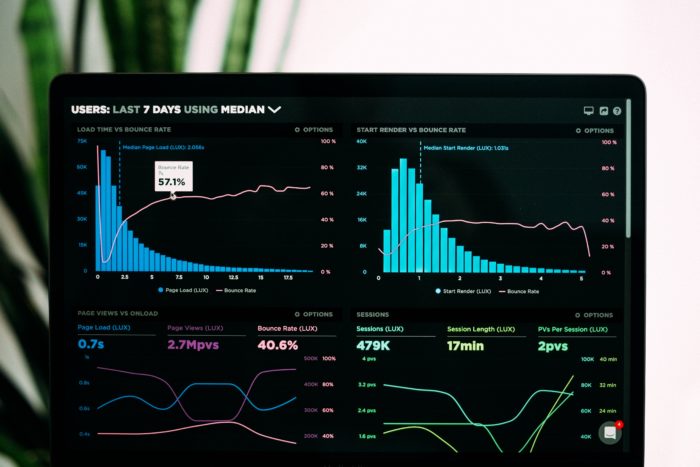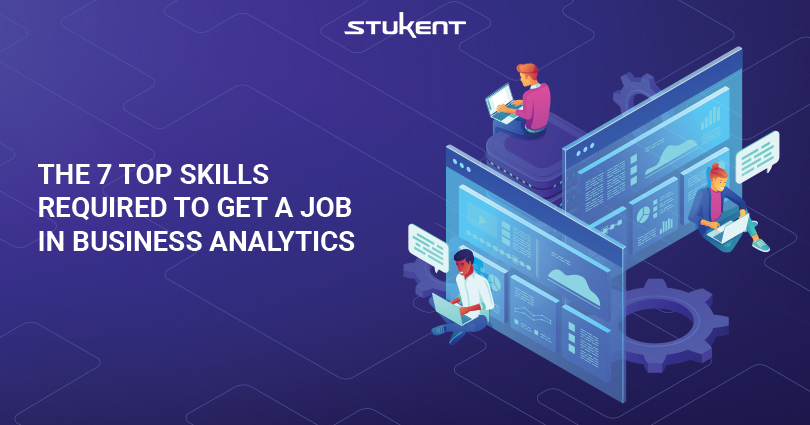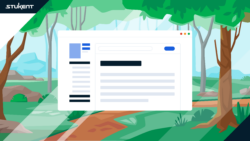According to the U.S. Bureau of Labor Statistics, the job market for business analysts is not only growing faster than other jobs, but also provides a higher salary than average. That’s a tough combination to beat. The typical employee in management analytics holds a bachelor’s degree, has less than five years experience, and earns $85,260 per year (2019 data).
Students now preparing for a job in business analytics need a well-rounded education covering the basics of how business works in general, but there are seven skills especially important to graduates hoping to land their first job in business analytics. Learn those well, and you’ll get ready access to the head of the line when the resumes are sorted.
To make sure you’re on the right track, check your current knowledge against the seven essentials below. If any are lacking, fill in those gaps before graduation. Don’t wait for a human resources manager to point out that you need more than a degree, you need specific abilities … seven specific abilities, to be exact.
Dr. Brennan Davis, author of the digital textbook “Business Analytics: Data Analysis and Storytelling for Business,” asked industry professionals from Google, Tesla, Oracle, and other leading companies what skills they thought were critical for business analysts. The seven points below are based on their responses.
7 Essential Skills for a Job in Business Analytics

1. Programming Language Knowledge Is Essential for Business Analytics
If you’re going to play the game, you have to know the language of the game. And business analytics is one place where being a native English speaker isn’t going to carry the day. You must be able to solve problems using computer algorithms – and that requires familiarity with programming languages.
Consider the following example:
Let’s say you want to mine data from Twitter. The project will require you to search millions of tweets to log how many times a certain keyword appears in those tweets. How long would it take you and your team to complete that task by hand? With the correct programming instructions, a computer can do it before you finish your next cup of tea.
Programming languages use a formal set of instructions to produce the outputs you desire. There are many to choose from, but the ones most-used in business analytics are R, SQL (Structured Query Language), and Python. With simple SQL commands you can execute database queries, work with records, retrieve data, create tables, set database permissions, and more.
2. Web Analytics Proficiency Keeps You Current in Business Analytics
The Twitter mining scenario given above is an example of web analytics, but it’s important to know that business analytics isn’t limited to online data. Maybe you collect data on your foot traffic by positioning a staff member at each entrance to your store. Their job is not only to greet visitors, but to record data about each: gender, age group, and time of visit (for instance). You can employ business analytics both online and off. The primary difference is your method of collection.
Web analytics seldom requires human counters. Digital tools can be used to tally an incredible array of data points. The most popular general purpose tool of all is Google Analytics, but you may find companies using Matomo, Adobe Analytics, or another platform. It is essential that you develop a firm grasp on the types of web analytics most important to your work and learn how to extract the correct data with whichever analytics program is used. The capabilities of analytics tools far exceed the real needs of most business analytics projects. Don’t get lost in the possibilities, focus on the data most necessary to provide the understanding you seek.
Here are some of the most important analytics metrics to track:
- Number of visitors and their source
- Keywords used to find your website
- Most popular pages on your site
- Actions taken by visitors on your site
- Conversion rates at specific points on the sales journey
- Time on site and exit page
Analytics tools can also provide information about browser type, returning versus new visitors, and more. Every report your analytics tool offers can be useful, but every report is seldom important to the work at hand. Don’t get lost in the data. Make the data work for you. Know what you’re looking for and how to retrieve it.
3. Spreadsheet Analysis Ability Is a Necessary and Valuable Skill
In the same way that analytics tools can extend and amplify the manual collection of data, spreadsheet ability can turn you into an instant math wizard. Microsoft Excel is the most popular tool for manipulating data in rows and columns, but other programs like Apple Numbers, Google Sheets, and Airtable are also popular.
Spreadsheets allow you to clean, structure, and integrate data. The better you are with spreadsheets, the easier it will be for you to get a job in business analytics. Working with data via Excel and similar programs is a highly-regarded and much-used skill. You’ll need to know how to sort data, use functions, interpret results, and make corrections to sheets.

4. Segmentation Skills Set the Stage for Effective Campaigns
Ask any seller of goods or services – online or off – who they’re targeting in sales campaigns, and there’s one answer you’ll hear far too often: “Everybody is my potential customer.” The failure to segment customers and potential customers into smaller, relatively homogenous groups is a primary reason for underperformance in marketing. “Everybody” buys nothing. You’re looking for “somebody” … and the better you are at identifying and segmenting the audience for your goods, the more effective you’ll be.
Segmentation allows firms to focus their limited time and resources on a limited number of customers. Analytics may reveal that one age group prefers a certain product, while a different age group is much more likely to buy a different product. Segmentation allows you to direct your advertising dollars to each group separately.
The challenge is in identifying which attributes to use for segmenting your audience. Common methods are according to demographics, psychographics, and behavioral differences. “Targeting” is the process of identifying which segment to pursue in a certain campaign. The business analytics textbook and simulation program provide plenty of real-life examples and experience with segmentation.
5. A/B Testing Skills Can Give You a Definite Edge for Jobs in Business Analytics
Everyone has an opinion, and it’s often the person on the team with the most pull or persistency who gets to call the shots. With A/B testing (also called “split testing”) you don’t have to rely on guesswork, gut feelings, or goading to determine which course of action is best. You can test those opinions scientifically and let your customers decide.
Here’s one way to think of the basic steps in A/B testing:
- Observe the situation, define a problem, then ask a question
- Create a possible (your hypothesis) solution or answer
- Develop an experiment to test your hypothesis
- Collect and analyze the results of your experiment
- Listen to the story those results tell you, then keep testing and improving until you’re satisfied the results you’re achieving are acceptable
Opinions are fine. Experience is fine. Intuition is often uncanny. But the proper application of scientific testing methods allows you to make data-informed decisions that are often more accurate than you could realize by any other means. Testing gets you further faster and helps you amplify your return on investment.
6. What Does Storytelling Have to Do with Business Analytics?
If the goal of data visualization is to help bring clarity to complex ideas, then part of the job in business analytics is to communicate findings efficiently. Typically, that is accomplished via charts, plots, and maps. Each platform has its own capabilities and ideal uses. You don’t need to be a graphic design artist, but you’ll want to be able to choose and create visualizations that will get your points across with minimum confusion. “Data visualization,” says Professor Davis, “is the key to effective storytelling with data for business analytics.”

7. The Final and Most Necessary Skill to Land a Business Analytics Job
The job market for business analysts is booming, but many people shy away from learning the seemingly complex and technically demanding skills required. Learning programming languages and manipulating databases sound like jobs for super-geeks.
But while it’s true that those topics used to be extremely difficult to learn, new tools and approaches have made it a whole lot easier to access and work with data. Students need to learn those tools, but more importantly … they need to learn to think like business professionals. An in-depth study of business analytics helps you do that.
Indeed.com currently lists 69,444 jobs in business analytics. 10,614 of those jobs are described as “entry level.” LinkedIn shows 48,100 results for business analytics jobs, and a Boeing Airlines Google Ad targets “data and analytics careers.” Is one of those jobs just right for you? It sure could be.
And that brings us to the seventh essential skill you’ll need to get the job you want. To learn the fundamentals of business analytics and become proficient in its practice, you’ll need to provide personal desire and focused action. You’ll have to bring those abilities to the table by yourself. Nobody else can do it on your behalf. The tools and schools you need are ready when you are.
How to Make Sure You Get the Job You Want in Business Analytics
May you find great success on this exciting journey. Business analytics skills are in high demand around the globe. Don’t allow anything to stand in your way. The door to opportunity is wide open … but only to those who are prepared to enter it.
Are You a Professor? Get Free Instructor Access!
Are you looking for ways to help business analytics students gain hands-on experience with the fundamentals of the occupation BEFORE landing their first job? Request free access to “Business Analytics: Data Analysis and Storytelling for Business” digital textbook.
[Request Free Access]
Dr. Brenna’s “Business Analytics” digital textbook helps students gain each of the critical skills listed above. Here’s what industry professionals have to say about “Business Analytics”:
“This textbook breaks down many fundamentals of business analytics and provides students with a pragmatic approach to solving real-world business problems.”
—David Cornella – Senior Data Analyst at Google
“Professor Davis’ book has a very strong coverage of the key tools and concepts required in the field of business analytics: from Excel (most underestimated and under-used analytical tool), to Web Analytics, to Data Mining, to Deep Learning. I wish all the candidates I am interviewing had this toolset at their disposal.”
—Dmytro Marushkevych – Sr. Director Data Science & Analytics at Razorfish
“Technology’s rate of change in business over the last decade has outpaced the curriculum of most university business programs when it comes to business analytics and the tools and knowledge needed to effectively drive data-driven decisions. Dr. Brennan Davis’s close connections with analytics leaders at today’s top companies ensure his content is up to date with the needs of industry and his book and courseware provide a modern platform to teach the foundational topics of business analytics.”
—Nate Veldkamp – Senior Manager, Analytics for Tesla






